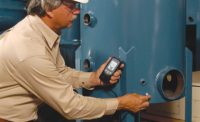Traditional Measurements
Duplex Measurements
Measuring Inside Car Cavities

|
|
|
Case 1: Paint system/zinc/steel
|
Case 2: Paint system/aluminium
|
|
Typical example of a paint system:
(1) Zinc phosphate (≈ 1 µm)
(2) Electrophoretic dip coating (≈ 20 µm)
(3) Primer coating
(4) Top coating
(5) Clear lacquer
|
MS =
magnetic-inductive channel
WS PS =
phase-sensitive
eddy current channel
WS AS =
amplitude-sensitive
eddy current channel
|



